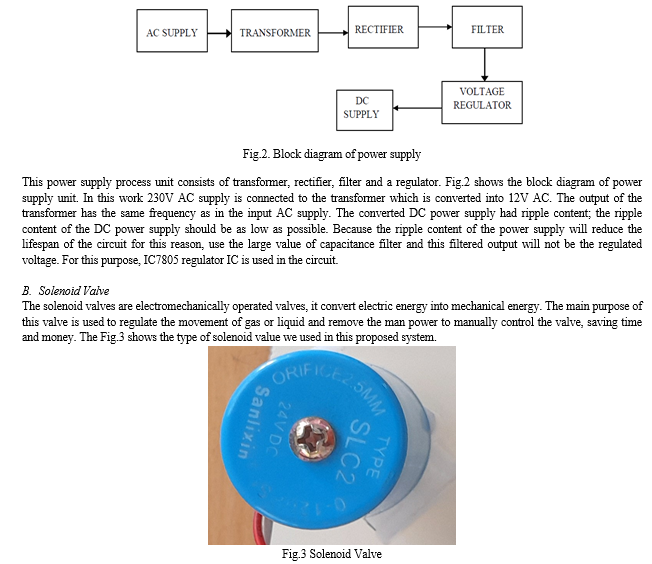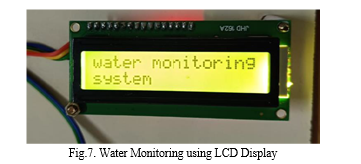Ijraset Journal For Research in Applied Science and Engineering Technology
- Home / Ijraset
- On This Page
- Abstract
- Introduction
- Conclusion
- References
- Copyright
IoT Based Domestic Water Supply Monitoring and Theft Identification System
Authors: N. Mekala, M. Suguna, N. Thillaikarasi, P. Selvakumar, R. Manikandan
DOI Link: https://doi.org/10.22214/ijraset.2024.58452
Certificate: View Certificate
Abstract
In the urban and rural areas, the water supply to the residents and commercial establishments is provided with a fixed water flow rate. Now a day’s most people’s utilize the excess water by connecting the motor pump or suction pump to suck the water directly from the area street pipeline which is considered as water theft. It causes enormous complications during summertime and also reduces their environmental resources. In this project, the proposed system is used to develop an IoT-based water supply monitoring and theft identification system by recording the flow rates at the consumer or user end. To implement the proposed water supply system, each consumer can be provided with a PIC-based microcontroller kit to record the flow rate using a flow sensor. The electrically operated solenoid valve is provided to the consumers to monitor water usage. If any excess water deduction occurs in the water supply pipeline the excess flow rate and corresponding charges will sent to the consumer ID. The valve is turned off using IoT to stop the water supply when the consumer fails to pay or uses excessive water LCD is connected with a Node MCU to display data nearby. The proposed framework is completely automated; there is no need for manpower. The domestic water supply monitoring and theft identification system offers several benefits, including improved water resource management, reduction in water wastage, and financial savings. Identifying and addressing instances of theft, it promotes fair usage and conservation of water resources, ultimately contributing to sustainability.
Introduction
I. INTRODUCTION
In urban territories with the enormous monetary development, the water request of individuals is additionally expanding. Water is mandatory for every one of their living in the earth. For that reason some peoples are not getting the adequate measure of water in all the seasonal time due to unequal distribution of water [1]. The water wastage is because of numerous reasons. We are utilizing drinking water for planting and water leakages are not checked accurately. In this proposed system water supply framework the PIC controller is associated with the flow meter and solenoid valve with relay circuit.
This framework is proposed to utilize an Ethernet for wireless correspondence with the goal that the data can be exchanged to the individual who is checking the framework. In past technique, individual who is keeping up will touch base to the place and check the association. The main purpose of this work is done by identifying the water leakages and operating error. To solve these problems the proposed work is planned and builds up with low cost model for continuous checking of water circulation in Internet of things platform. The valve turns on/off to stop the water supply at whatever point the flow rate surpasses a predefined restrain. The solenoid valves are likewise controlled by relay circuit to control flow of water as needs be for a settled span of time. IoT is a simple development system [3], which can be used to detect millions of objects impart and share data all are organized in a manner over Internet Protocol (IP) systems.
Once the fixed time over the individual person will go to a similar place and close the valve. It is wastage of time. The proposed automated framework is completely programmed thus human work and time is diminished.
Embedded systems are very popular these days most of the Electrical, Electronics, and Mechanical Chemical, Industrial, Medical, Space and many more areas have the embedded systems in their applications [12]. Main objective to implement this project is to design and develop a low cost reliable and efficient technique to make proper water distribution by continuous monitoring and also controlling it from a main server for that we can clear all water related problems [9]. There is no need of man power, and there is no need to keep on monitoring and user friendly. These will aggregate the information constantly and afterward exchange the information to the cloud [6]. The remaining part of the manuscript is structured as follows: Section 1 describes the introduction of IoT and section 2 represents the block diagram of proposed system. The hardware mechanism discussed in section 3. Section 4 represents the hardware implementation and finally section 5 and 6 discussed the results and conclusion & future work are presented in final section.
II. BLOCK DIAGRAM OF PROPOSED SYSTEM
The experimental setup is made and tested in the Electronics Laboratory at Dhirajlal Gandhi College of Technology. The 230V AC supply is given to the rectifier circuit and it will convert the DC supply. The regulated 12V supply is given to the ARDUINO UNO board and it will derive the board. The block diagram of the domestic water supply theft identification system is shown in Fig. 1. In this setup consists of a PIC, flow sensor, Node MCU, relay, and GSM module. The Node MCU is an employed development board in IoT applications; it provides a versatile and cost-effective approach to connect devices to online monitoring. All the data collected from ARDUINO is connected with a NodeMCU unit and it process continuously and push data on cloud. The ARDUINO is a microcontroller board based on the ATMEGA328, it is an 8 bit microcontroller has 14 digital input and output pins. The water flow sensor is made up of a plastic valve body with a rotor it uses a pinwheel sensor to measure how much water or liquids has moved through it and water flows through the rotor rolls also speed changes which outputs the corresponding pulse signal. Flow rate measured in Liters/sec/min/hour. By counting the number of pulses from the output of the sensor, can effortlessly track water movement.

GSM (Global System for Mobile Communications) is a type of cellular network and it will be operated in the frequency range of 900 MHz or 1800 MHz bands. Mainly the GSM is used to generate a message when abnormality or theft is occurring in the water supply line. The valve turns off to stop the water supply whenever the consumer does not pay the exceed flow rate tariff charge. A Solenoid valve is an electromechanically operated valve. A Solenoid valve also known as an electrically operated valve is an automatic valve that serves the purpose of removing manual handling. These valves are used in pipelines to supply water with automatic on/off control. We can automatically operate valves and supply water when it is needed which reduces manual work. Relays are used to drive solenoid valves.
III. HARDWARE MECHANISMS
In this proposed hardware implementation consists of the following components:
- Power Supply Unit
- Solenoid Valve
- NodeMCU
- Water flow sensor
A. Power Supply Unit
A power supply is a device or system that supplies electrical energy to the load. A power supply unit is required to provide the appropriate supply voltage.

In this solenoid valve operated at normally open, the valve is closed when de-energized and open condition the current activates the magnetic field and moves the plunge. When the valve is normally closed, an energizing current lifts the plunger to uncover the opening and allows the medium to flow through the valve. The solenoid valve coil voltage is 27V DC and it the diameter is 6 cm.
C. NodeMCU
Node MCU is an open source firmware for which open source prototyping board designs are available. The name NodeMCU combines node and MCU (micro-controller unit).The NodeMCU is an extensively employed development board in IoT applications, providing a versatile and cost-effective approach to connect devices to the internet. It features Wi-Fi and programming capabilities, facilitating speedy prototyping and deployment of IoT solutions. The Fig.4 shows the Node MCU module.

Similarly a digital water flow meter is an electronic device that measures the flow rate of water in pipes or channels. The sensor is used to identify the movement of water and then converts this information into a digital signal it can be read by a display or transmitted to a computer system for analysis and also it detect any changes or irregularities in the flow, and to control or regulate the flow as needed. The total volume of fluid flowing through the water flow sensor is equal to the water flow rate (Q)- unit L/s multiplied by time t (unit s).In this system YF-S201 sensor is used to measure the water flow. When the water flows through the valve it rotates the rotor and the change can be observed in the speed of the motor. The water change is calculated as output with pulse signal by the Hall Effect sensor. The Hall Effect sensor plays a main role in this proposed system. The voltage difference is induced in the conductor due to the rotation of the rotor in the flow sensor. The flow sensor working under the voltage range is 4.5V~24V DC and current range is 15mA, flow rate is 1-30L/min.
IV. HARDWARE IMPLEMENTATION
The hardware implementation of this proposed system is made and monitoring the water flow and water theft identification in domestic appliance. The output results of this proposed system is displayed in the LCD screen and also got mobile notification regarding water speed is high during theft process occurred at a time. Fig.6. shows the hardware implementation of the domestic water supply system. In this system water flow sensor is used to measure the flow of water at various points in the water supply network.
It can be installed at the main water inlet of individual household connection to monitor water usage. In this proposed system smart water meters are used for accurate measurement and monitoring of water consumption at individual households. These meters can transmit real time usage data to the central monitoring system mainly the microcontroller act as the brain of the system, it will gathering data from sensors and controlling various operations. They can process and analyse the sensor data, communicate with the central server, and trigger alerts or actions based on predefined conditions. The system can be equipped with audio or visual alarms to notify authorities or users about abnormal events like leaks, low pressure, or suspicious water usage. Notifications can also be sent via SMS, email, or mobile applications. To prevent tampering and ensure data security, the system can incorporate measures such as encryption, authentication protocols, and physical security for critical components. Depending on the location and availability of electrical power, the system may require a stable power source. This can include a combination of mains electricity, battery backups, or solar power for remote areas.

A communication module enables data transmission between the hardware devices and the central monitoring system. The options can include Ethernet, Wi-Fi, cellular (GSM/3G/4G), or IoT protocols like LoRaWAN or NB-IoT. A user interface can be developed to allow users or administrators to monitor and manage the system. This can include web-based dashboards, mobile applications, or dedicated control panels. It's important to note that the specific implementation details, such as the choice of sensors, communication protocols, and software platforms, will depend on the requirements and constraints of the project. Professional consultation and collaboration with experts in the field of water supply systems would be beneficial to design and deploy an effective and tailored solution.
V. RESULT & DISCUSSION
In this proposed system the IoT based domestic water supply monitoring and theft detection process is designed to detect and find the water theft. The system utilizes IoT device to detect the water theft. The microcontroller will access the sensor data’s from Hall Effect sensor and send the SMS alert to their corresponding mobile number. For that reason we can reduce the water demand in peak period of summer time in our area.


In recent days smart cities taking ground water around the world, it’s important to have smart cities have smart solutions to save useful resources as important as water. Smart does not mean public Wi-Fi and using smart-phones to make our life easy, but also it’s about looking at the basic needs of the people efficiently and more smartly. Hopefully, this IoT project will bring a lot of change and bring water connection to all the households, such as many cities where water supply not yet reached. In future it will implement all the smart cities to rural areas to making our country without water wastages and also benefited everyone to live happily with sufficient water supply system.
Conclusion
The proposed work is an essential requirement for the modern world people to solve the water related issues. The best part of the system is its ease of designing and the hardware is easily available at cheaper rate. Dependable data monitoring from the central server helps the surroundings in getting adequate water by incorporating automatic theft control. The above facilities are established only due to the use of water flow sensor and also solenoid valve. As we control the flow of water over a concern limit and a particular rate or else it forcibly switches the system OFF. By implementing the proposed research work, the water theft in the government pipelines can be absolutely avoided and also the habitats can achieve the additional water requirement by making purchase. So we can easily ensure poor water supply for all users by identifying water theft and monitoring by taking necessary action to rectify the water demand. This real time automation implemented in the system avoids wastage of water and reduces time. Hopefully the IoT based project will bring a lot of change and bring water connection to the entire domestic household and many other such cities where water supply has not reached yet. This proposed work is not only suitable for water supply, but in future our government can supply liquid petroleum gas and other fuels through pipelines using this project.
References
[1] Anil Gantala, PaparaoNalajala, N.Vasudheva Reddy, Bhavana Godavarthi –“Public water supply monitoring to avoid tampering and waterman fraud” , International Journal of Mechanical Engineering And Technology, Vol 8,Issue 8,August 2017. [2] Anubha Pachal, Ketakee Dagade, Kiran Pawar – “Automated water supply system and water theft identification using PLC and SCADA”, International Journal of Engineering Research and Application, ISSN: 2248 – 9622, Vol 4, Issue 4, April 2014. [3] A.Mancharkar and K. Rakesh, \"Automated water distribution system for smart city using PLC and SCADA\", International Journal of Emerging Technologies and Engineering(IJETE),ISSN 2348-8050, vol.3, Issue 3, March 2016. [4] B.Sasikumar – “Automated water conservation and theft detector using IOT”, International Research Journal of Engineering and Technology, ISSN: 2395 – 0056, Vol 5, Issue 4, April 2018. [5] G.M.Tamilselvan, V.Ashishkumar, S.Jothi Prasath, S.Mohammed Yusuff – “IOT Based Automated water distribution system with water theft control and water purchasing system”, International Journal of Recent Technology and Engineering (ISSN: 2277 – 3878) Vol.7, Issue 4S, November 2018. [6] Gande Chaitanya,MudassiraTabassum.J ,Akila.S – “Smart Urban Water Supply scheme with Water Theft Detection System” , International Journal of Pure and Applied Mathematics(ISSN: 1314-3395), Vol.119 NO 15,2018. [7] J.P.ShriTharanyaa, A.Jagadesan, A.Lavanya – “Theft identification and automated water supply system using embedded”, International Journal of Advanced Research in Electrical, Electronics and Instrumentation Engineering, ISSN:2278 – 8875, Vol 2, Issue 8,August 2013. [8] Krishna Anandkishor Tiwari, Sanket Tukaram Jadhav- “Water Management and Theft Detection System”, The International journal of analytical and experimental modal analysis, ISSN NO: 0886-9367, Vol.12, Issue 9, September2020. [9] Mrs. Gaikwad Sonali Ashok, “Water antitheft and quality monitoring system by using PLC and SCADA”, International journal of electrical and electronic engineering research, ISSN 2250-155X, vol3, Issue 2,June 2013. [10] N.B.Bhawarkar, N.M.Verulkar, R.R.Ambalkar, K.U.Pathak – “Automatic water distribution system using ARM controller”, International Journal of Research in Electronics (ISSN: 2349 – 2522) Vol.3, Issue 01, 2016. [11] P.Mukesh Aravind, S.Sukhumar, S.Karthik, “PLC based automatic corporation water distribution system using solar energy”, International Journal of Engineering Research and Technology (IJERT), Vol.2, No.12, December2013. [12] Simon Peter Khabusi, Rajini Jindal- “Modeling and Predicting Piped Water Theft Using Machine Learning Approach”, International Journal of Engineering Research &Technology (ISSN: 2278 – 0181) Vol 09, Issue 05, May 2020. [13] Sagarkhole, Tushar kolape, “Automated Drinking Water Supply System and Theft Identification’’, International Journal of Innovative Research in Computer and Communication Engineering Vol.3, Issue 3, March 2015. [14] S. Chen, B. Mulgrew, and P. M. Grant, “A clustering technique for digital communications channel equalization using radial basis function networks,” IEEE Trans. on Neural Networks, vol. 4, pp. 570-578, July 1993. [15] J. U. Duncombe, “Infrared navigation—Part I: An assessment of feasibility,” IEEE Trans. Electron Devices, vol. ED-11, pp. 34-39, Jan. 1959. [16] C. Y. Lin, M. Wu, J. A. Bloom, I. J. Cox, and M. Miller, “Rotation, scale, and translation resilient public watermarking for images,” IEEE Trans. Image Process., vol. 10, no. 5, pp. 767-782, May 2001.
Copyright
Copyright © 2024 N. Mekala, M. Suguna, N. Thillaikarasi, P. Selvakumar, R. Manikandan. This is an open access article distributed under the Creative Commons Attribution License, which permits unrestricted use, distribution, and reproduction in any medium, provided the original work is properly cited.

Download Paper
Paper Id : IJRASET58452
Publish Date : 2024-02-15
ISSN : 2321-9653
Publisher Name : IJRASET
DOI Link : Click Here
 Submit Paper Online
Submit Paper Online

